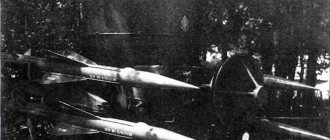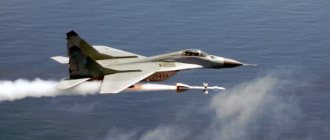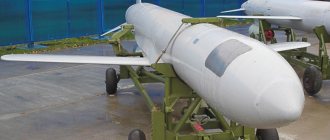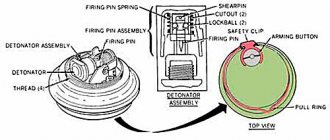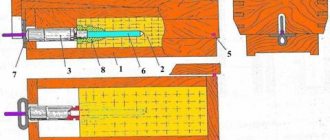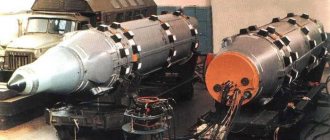Aviation aeroballistic missile X-15
The X-15 missile has a wingless design with a cantilever all-moving tail (see projections).
The body is divided into compartments: instrumentation, cargo with warheads, engine compartment and control drives. Due to the high flight speed (at M = 5 - more than 1000 degrees), the rocket body experiences significant aerodynamic loads and heating; to ensure the required safety margin, it is made of titanium OT4-1 and VT-5, has external thermal protection and internal thermal insulation. The surface of the rocket airframe is covered with a special metallized coating to improve reflective characteristics during radar irradiation. A design feature of the X-15 was the virtual absence of hatches - installation and operational, through the gaps of which the components could be exposed to heat flows. Even when installing the steering wheels, access to their mounting points was carried out from the end ends of the steering surfaces.
The composite nose cone of complex ogival shape was developed in several design options. In a three-layer construction, each layer was formed from a different type of fabric, impregnated with a binder resin and heat treated, then the next one was applied, etc. This process was complex and lengthy. The two-layer design with fiberglass lining has become more successful and technologically advanced. The fairing was manufactured in rigid molds using the pressure impregnation method with simultaneous pressing of metal frames using glue. On the outside it was covered with a layer of thermal protection.
As heat protection for the metal structure, an external coating with a special material was used, which also played a radio-absorbing role. A layer of thermal protection had to be applied to the surface of the hull, gargrots and rudders, maintaining a given thickness, followed by heat treatment for baking. A liquid layer of thermal protection material was applied to the metal compartments directly in rigid molds using the pressure impregnation method, and to the steering wheels by vacuum “sucking through” and forming in an autoclave.
During heat treatment, a number of assemblies were supplied already partially assembled, and the composite parts included in them warped. To compensate for deformations, they began to supply metal parts made not according to structural, but according to technological drawings, the dimensions of which were set in anticipation of the magnitude of temperature deformations, and the products themselves were heated in rigid molds.
The rocket is controlled by deflecting all-moving rudders equipped with electromechanical drives. Two lower rudders, nicknamed “flippers,” controlled the rocket along the pitch channel when deflected together, and along the roll channel when deflected differentially. They also counteract the heeling moment when the upper rudder is deflected to correct the course.
An innovation was a solid fuel engine of an original design, used for the first time in the USSR on a rocket of this class. The dual-mode solid propellant rocket engine-160 has a two-chamber design, connecting two stages in one housing - the starting and sustaining stages, separated by a partition and switched on in series with their ignition systems. The engine uses mixed fuel, combining high-calorie fuel and an oxidizer that releases the oxygen necessary for combustion. The fuel is cast directly into the engine housing with a profiled internal channel of a star-shaped cross-section, which increases the area of gas formation and, accordingly, the operating pressure in the combustion chamber and thrust. For long-term storage, the internal cavity of the engine charge is sealed with a special shell, pressurized with inert gas.
The Kh-15 missile is equipped with a small-sized special warhead with a power of 350 kt with a thermonuclear charge (training missiles carry a simulator of a special warhead and a low-power high-explosive charge that allows you to control the hit).
The handlebars are made of titanium OT-4 with an external heat-protective coating, the handlebar toes are made of heat-resistant tungsten-molybdenum alloy VM-1. The edging of the compartments and gargrots is made of heat-resistant steel VZh-100. The Kh-15P and Kh-15S missiles have a radio-transparent ogive-shaped nose cone with thermal insulation (TKCh-6), lined with ATOM-2 fabric.
When mastering the production of the X-15 missile at the DMZ, new technological processes were introduced:
- manufacturing fairings of a two-layer design in rigid molds using the pressure impregnation method with simultaneous pressing of two metal frames using VK-20 glue.
- applying MKT heat-shielding material directly to the metal compartments of the rocket airframe in rigid molds using the pressure impregnation method
- applying heat-protective material to steering wheels using autoclave vacuum molding.
To manufacture large-sized parts of the X-15 rocket, requiring severe heat treatment conditions, a large-sized, high-temperature PAP furnace with a temperature difference across zones of ±50° was developed and built at the DMZ. This made it possible to carry out high-quality heat treatment of parts without residual deformation, incl. in rigid devices (thermal calibration). Shells made of VT-20 alloy were processed using this method.
Modifications:
- X-15 - basic,
- Kh-15P - anti-radar (see.
). Designed to break through enemy air defense zones with long-range aircraft. Equipped with a passive radar seeker and fragmentation warhead. - X-15S (X-15A) - anti-ship (see.
), is equipped with a noise-resistant active radar seeker operating in the mm-band. The Kh-15S missile is fired according to the “fire and forget” principle, but before launch, relatively accurate coordinates of the target, its course and speed must be entered into the memory of the control system from the carrier. The X-15S missile is equipped with a penetrating warhead weighing 150 kg. Offered for export under the designation X-15SE.
The Kh-15 missile is launched from MKU-6-1 rotor units or from single beam holders. The X-15S can be carried by Tu-160, Tu-95MS, Tu-22M3, Su-27K and Su-27IB aircraft. The Tu-160 carries 24 Kh-15 missiles on 4 MKU-6–1 turret launchers in 2 compartments. The Tu-22M3 is equipped with one MKU-6–1 in the compartment and four external AKU-1, mounted instead of the Kh-22 missile beam holders. The release and cleaning of AKU-1 is controlled by the air system.
The Tu-22M3 weapons complex includes an on-board missile control system (SURO), which provides target designation, preparation for firing and control of launchers. The basis for carrying out a combat mission is the detection of targets and the establishment of their coordinates, carried out before departure or in the air by the aircraft’s on-board equipment. Receiving data on course, coordinates and speed from the aircraft's navigation complex, SURO processes the information and prepares the INS of missiles, including the exhibition of gyro-stabilized platforms (i.e., their binding to their position in space), entering data about the target, determining the entry into the permitted zone launches and automatic readiness control, during which shooting can be carried out.
The missile is dropped from the launcher, after which the engine is started. The engine, operating in the starting mode, ensures acceleration of the rocket with an altitude climb of up to 40 km. Subsequently, the engine switches to propulsion mode, and the missile moves along a trajectory close to ballistic, accelerating to hypersonic speed. The homing systems of the Kh-15P and Kh-15S missiles are turned on at the final section of the trajectory. In case of loss of the target and when the enemy radar is turned off, the movement is carried out to the aiming point using the inertial control system (see.
). The flight of the X-15 to a target at a distance of 200 km takes about 180-200 seconds, leaving practically no time for the enemy to react, and the altitude profile of the flight makes it inaccessible to missile defense systems and fighters.
Shock shock
This is a very important supersonic concept that determines the flight of a hypersonic rocket and, like Elbrus, has two application points, outside and inside the rocket. It is often and widely confused with a shock wave, but it is not the same thing. A shock wave occurs in a supersonic flow as the impossibility of air disturbances from any streamlined obstacles to be absorbed forward. They move only at the speed of sound and accumulate in front of the source of disturbances, unable to escape from it up the supersonic flow. The flow pushes and compacts this accumulation of disturbances, creating air compaction here. It occurs strongly and sharply, spasmodically, at a distance of a couple of molecular runs per ten-billionth of a second. This instantaneous step in density growth is a compression shock.
And in the same jump-like manner the flow is slowed down, instantly slowing down and flowing slower after the jump. The decrease in the kinetic energy of the flow turns into an increase in the potential energy of compression and heat. With a jump in density, pressure and temperature also increase sharply. In the shock wave, part of the flow energy is lost and consumed, forming gas-dynamic losses. This causes an additional slowdown in flow. Energy losses in horse racing are different, and this difference can be worked with.
The shock wave can be straight or oblique
. The direct shock stands perpendicular to the flow, “straight,” and decelerates the flow to subsonic, completing the supersonic flow. It has the greatest energy losses. Oblique shocks lie at an angle to the flow, leaving it supersonic behind them and causing fewer losses. If you need to slow down and compress the flow by a given amount, then compression with one shock will give more losses than the total of two or three weaker shocks. Oblique shock waves in the engine compress the air in a sequential cascade with less energy loss, which is inexorably wasted from the energy of the rocket's motion, slowing it down.
Beyond the jump
Gas can have two routes. If the cause of the jump is nearby—any hard surface at an angle of attack, a wedge, a cone, or another shape—then the air flows along it compressed. Behind the shock, the compressed, heated and slowed down flow continues. Then the shock wave is the leading surface and the beginning of the compressed flow.
And when there is no disturbing object behind the shock, for example in an open atmosphere, then the compressed air behind the shock begins to expand unhindered. The higher the compression ratio, the more powerful the expansion. Its speed gives rise to inertia, and the expanding air skips the parameters of the atmosphere without stopping at them. A vacuum arises, which is soon collapsed by the surrounding atmospheric pressure until it equalizes with itself.
Deviation from equilibrium followed by a free return to it is a wave process. And the entire structure—the shock wave, the area of compressed air behind it, and the region of rarefaction—makes up a shock wave. In it, the shock wave is only the front surface as thick as that very couple of molecular paths. The shock wave resembles a stack of two pancakes, compression and rarefaction, with a thin burn of the shock wave on the front compression pancake.
In a hypersonic rocket
The shock wave works both internally and externally. You could say he creates a hypersonic missile, being its sculptor. The main way works is the formation of compressed streams. They arise under the wings and body due to the angle of attack and create lift for the rocket. Supersonic shock systems are organized inside the engine to ensure its proper operation.
Flight of the Bumblebee, or Tic-Tac-Toe Game
A hypersonic engine immediately changes the aircraft, giving it greater capabilities and creating a new combat weapon from it. The range of a hypersonic missile can far exceed that of a glider. With more intense maneuvering, the speed of the hypersonic missile will not drop, supported by the engine. And this is a direct combat quality - the degree of invulnerability to interception. A hypersonic cruise missile is more difficult to intercept due to its “range plus maneuvering plus speed” trump card, which exceeds the capabilities of a hypersonic glider.
Maneuvering
— “armor” of a hypersonic missile, the main factor of invulnerability. Maneuvering prevents interception by constantly changing the targeting of interceptor missiles and bringing them close to critical flight modes, fraught with the termination of the pursuit. Anti-missiles are forced to constantly develop adjustments to their guidance and change flight, as they approach the target more and more intensely, increasing their overloads to a critical level. The organization of anti-missile maneuvering can be based on different algorithms.
Let’s imagine that the flight control system virtually cuts off a piece of the calculated trajectory 10 or 15 kilometers long in front of itself. At the far end of this segment, the control system draws a square perpendicular to the flight with sides a couple of kilometers long, pierced by a trajectory in the center. The square is divided into equal cells, like tic-tac-toe. So the space in front of the rocket is split into a bunch of diverging spatial segments stretching forward, each of which rests on its own “tic-tac-toe” cell.
The flight control system includes a random number generator. He throws his choice strictly randomly into one of the tic-tac-toe cells. An aiming cross is drawn in the selected cell; the others remain zeros. After which the control system directs the rocket to this randomly placed cross.
Having flown through the segment and ending up in a square with a cross, thereby moving slightly from the central spoke - the calculated trajectory, the control system cuts off another piece from the further trajectory, and the game repeats. At the end of the segment, “tic-tac-toe” are again drawn across, and a target cross is placed strictly randomly.
Why is the selection of crosses strictly random? If there was at least some kind of system in this, it could be “seen through” by the enemy’s more powerful computing tools and algorithms, which would aim their anti-missile missile at the cruise missile. Future movements through any system can be correctly predicted and the interception vehicle can be directed to the correct meeting point. But a random choice cannot be predicted.
Special logical blocks as part of the flight control system do not allow the rocket to go beyond a two-kilometer square. Otherwise, step by step, you can fly into deep deviations from the trajectory, critically moving away from it. And then you won’t be able to catch up with the calculated trajectory. Logical blocks monitor the relationship between local tic-tac-toe movements and the general direction of flight to the target. As a result, the movement of a cruise missile resembles something between the flight of a bumblebee and the swinging of a maple leaf, but performed in a hypersonic format. This makes intercepting a missile critically difficult, but does not make it impossible—never say never.
Flight of a hypersonic missile
consists of large geographical elements of bypassing problem areas and anti-missile sites and local anti-missile maneuvering superimposed on them, which can be intensified with information about the launch of an anti-missile missile. The choice of architecture and maneuvering modes is a careful matter and also does not fall into the broad information exchange.
Change is on its way
But technology is developing faster, and with all the modernizations, the gap from what can be done today begins to grow. This is how a new generation of aircraft arises. The Eagle and the Owl will be replaced by the next generation of aviation “strategists”, already being created and heading towards testing. In both hemispheres of the Earth it is now designed in the same way, in the form of a secretive subsonic flying wing. The PAK DA, a promising long-range aviation complex, is being prepared to replace the Tu-160. The subsonic aircraft relies on stealth. Various estimates imply its significant reduction in size and weight, estimated at 150 tons, with a flight range of up to 15 thousand kilometers. The range of weapons is expected to be wide, covering both missile and bomb ranges. PAK DA will become more universal, covering the range of B-2 targets.
The B-2 Spirit will give way to the outwardly similar B-21 Rider, which will continue to develop the principle of stealth and reduction - while abandoning the pursuit of range and payload. Due to the developed network of bases and the global ability to refuel in the air, the combat radius of the B-21 will be reduced to 4,000 kilometers, and the payload weight will be limited to 12-13 tons. High engine efficiency will reduce fuel consumption. All this will reduce the size of the aircraft and further enhance its stealth. And the fact that it is approximately four times cheaper than its predecessor will make it possible to build much more aircraft (with comparable combat power of one aircraft), thereby increasing the total strike potential of this segment of strategic aircraft.
Simultaneously with the new subsonic “stealth” wings, supersonic “strategists” with advanced aerodynamic features, new capabilities and high combat characteristics may also appear. Time will tell when the new technology will begin to fly, what it will be armed with, what it will actually be like, and how it will carry out its strategic tasks.
Stratospheric travelers
The atmosphere in which airplanes fly is divided into two dissimilar parts, two different “habits.” The lower part of the atmosphere is called the troposphere. It accumulates the energy and violence of solar heat, with the help of which almost all weather phenomena occur. The troposphere is characterized by dynamics and turbulence; it is saturated with various vertical movements of the environment and clouds of all types. At an altitude of 10-12 kilometers, the troposphere is separated by a rather noticeable boundary from another space located above - the stratosphere.
The stratosphere is structured differently: it is laid out in even layers that do not mix dynamically. That is why it is called the stratosphere, from the Latin stratum - “layer”. There is practically no vertical movement in it, so the flight in it is usually calm, without shaking, and the low air density allows it to develop high speed. The calmness of the stratosphere saves fuel consumption to fend off various disturbances, because the wings, stabilizers and fins create their force in a deflected position, and this is always additional air resistance. For short ranges this is not so significant, but at strategic ranges there are no trifles.
In addition, the absence of turbulence reduces the load on the aircraft and reduces the accumulation of metal fatigue, extending operational life. Therefore, the stratosphere for strategic aircraft is the basis for long (and multiple) ranges. However, they use this basis in different ways. Both of our heroes use the stratosphere as an echelon to cover strategic distances, as a calm and fast highway. Along which you can rush until you approach enemy airspace. And this is where the differences begin to appear. The Tu-160 can continue to move at supersonic speed, while the B-2 will descend and sneak as close to the terrain as possible, trying to completely blend into the terrain.
The maximum flight altitude of both aircraft is approximately the same: 15,200 meters for the B-2 and 16,000 meters for the Tu-160. Why exactly so much? The fact is that the stratosphere begins at different heights at different latitudes of the Earth. At the poles, the lower boundary of the stratosphere lies at an altitude of eight to nine kilometers. At the equator, the troposphere, pumped up by the equatorial rays of the Sun, bubbles more intensely, accelerating the ascending currents to greater heights, and pushes the stratosphere higher, to altitudes of 15-17 kilometers. The maximum flight altitude of the B-2 corresponds to the ability to fly in the stratosphere at any latitude, remaining in its quiet layers and saving fuel by minimizing control efforts.
